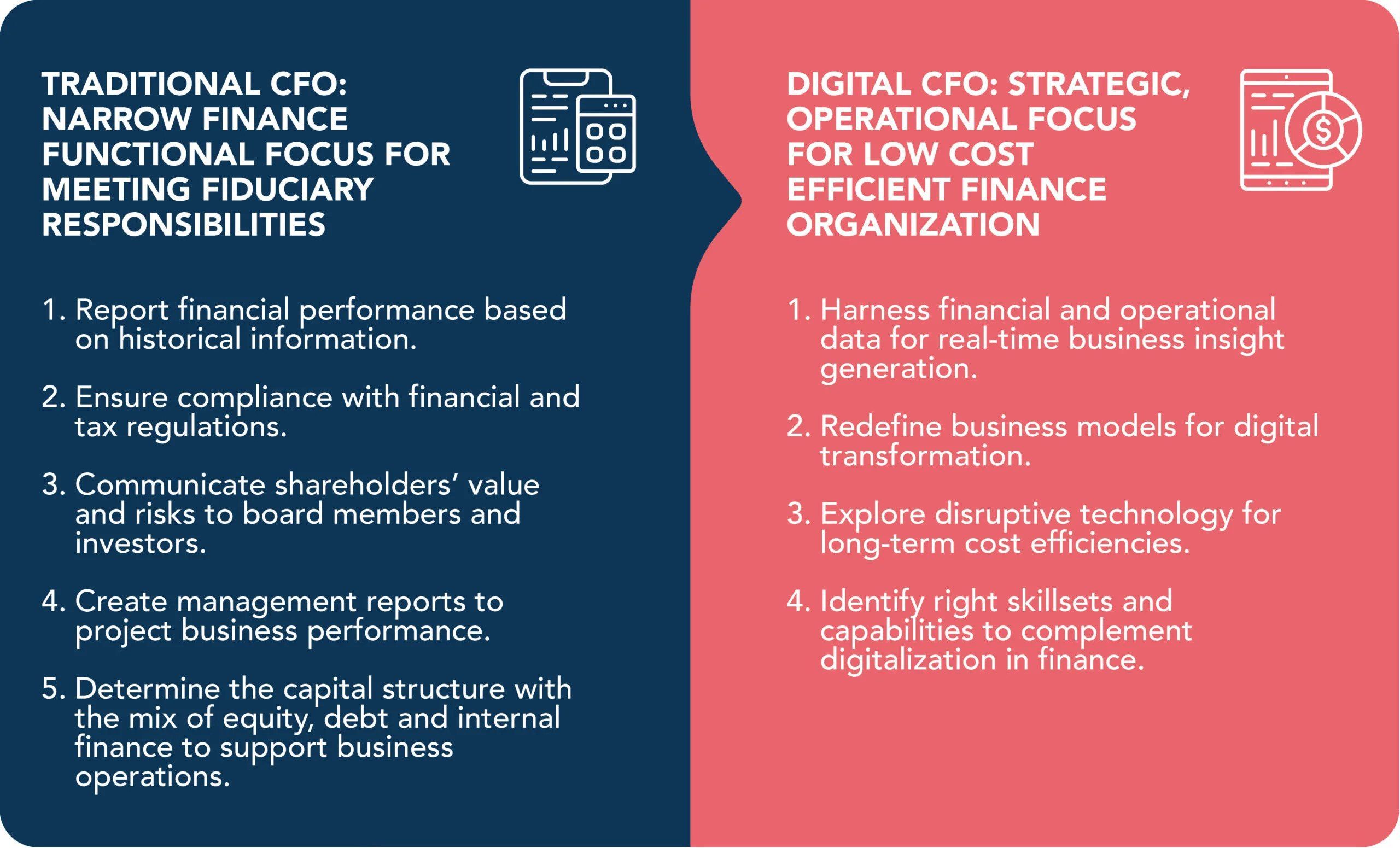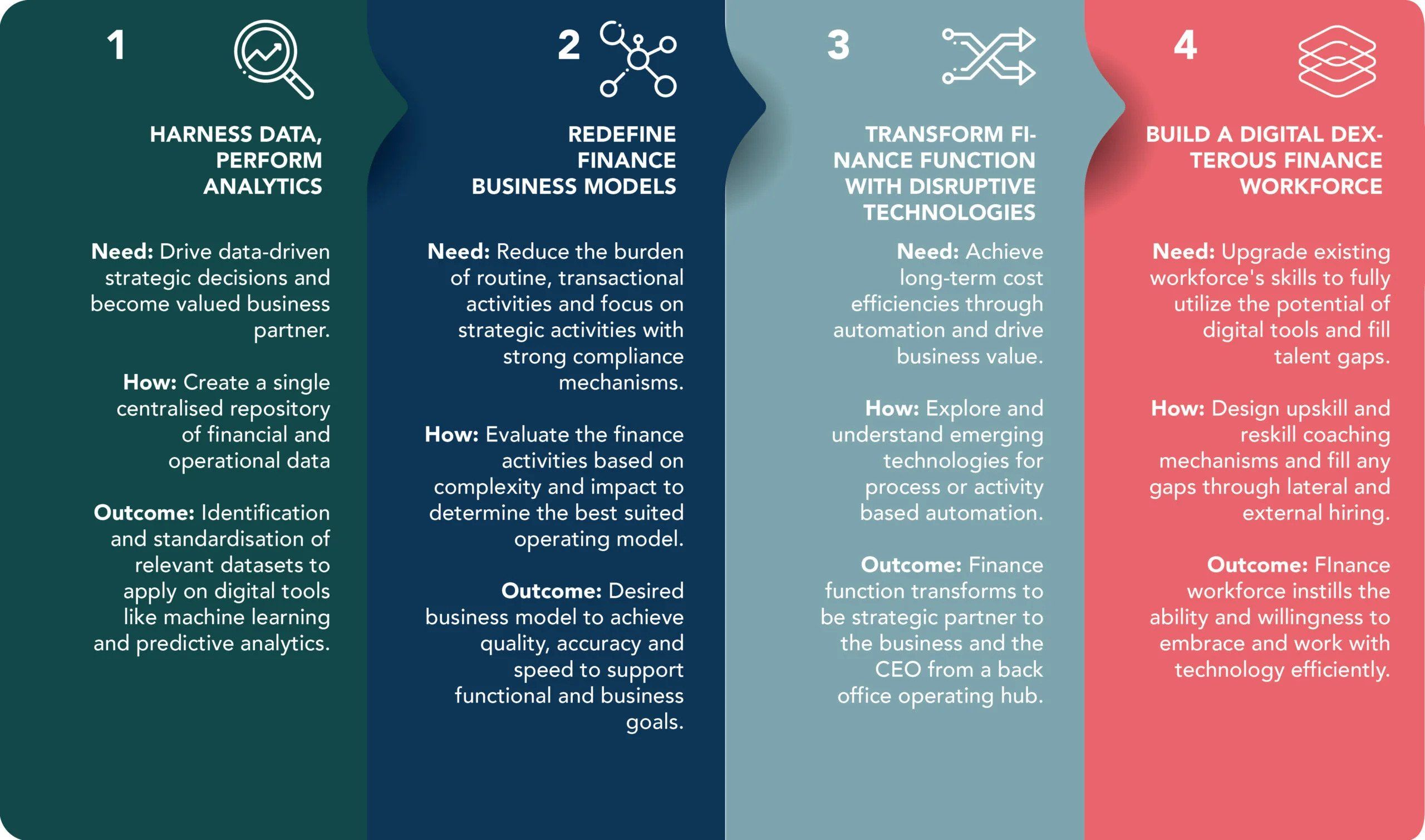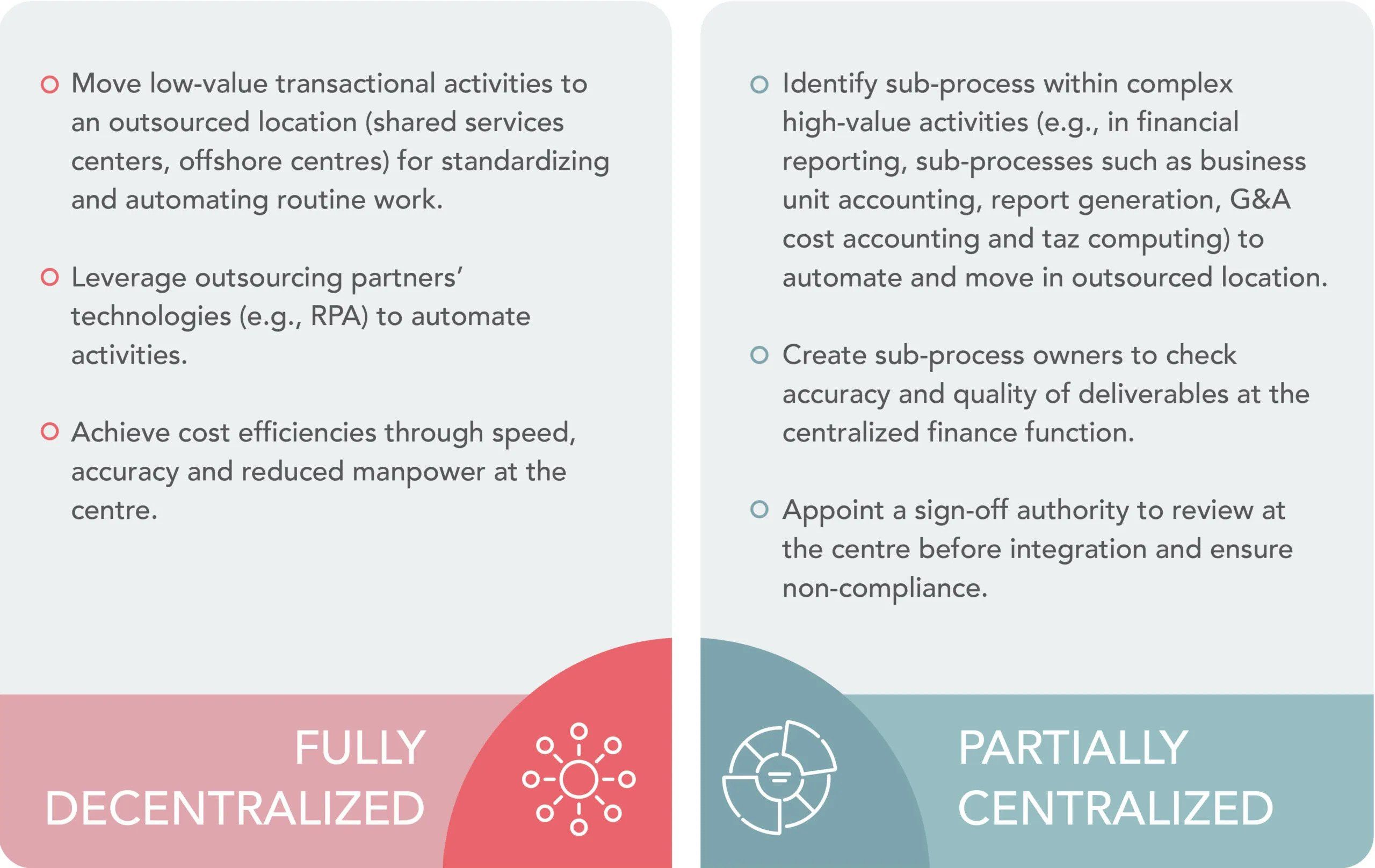The 3 Key insights:
- Chief Financial Officer (CFO) is now a strategic partner for the board and top leadership. His/Her perspective on the adoption of technology and achieving strategic growth goals is an important factor for an entity’s success.
- Understanding the technology bottom-up is imperative for the CFO. Digitization of the finance function should be the number one priority. It should lay the foundation to:
- Identify skill gaps in the finance function
- Align it with new business model innovation
- Look at M&A as a powerful mechanism to acquire skills, technologies and business model innovations
- For a CFOs to truly turn digital, focus must be toward the new digital transformation initiatives. Moreover, focus on compensation strategy, build new measures of performance, and understand regulatory compliance in this new digital world order.
Introduction
CFOs have a strong need, ambition and influence to drive business growth. The role is moving towards predicting the future rather than reporting the past. Consequently, adopting the digital wave is key to ensuring that they are not left behind. The key imperatives for financial leaders to become digital leaders are:
- Creating new value from data
- Enabling digital transformation across the enterprise
- Using the power of data to align long-term business goals
“The CFO role has moved beyond just finance and accounting. It’s a much more multi-faceted role that includes the strategic use of technology to drive business growth and operating velocity*“
– John Murphy, Executive Vice President and CFO at Adobe
*Digital Is Disrupting The Role Of The CFO. Here’s How
Figure 1: Evolving Role of the CFO

Role of a Digital CFO
Today, and in the future, CFOs must take financial and operational data to influence business decision-making and strategy. Now, they need to push digital boundaries and increasingly harness data to generate insights and shape forward-looking business models.
While meeting business needs, CFOs can become powerful digital leaders with their ability to access and analyze vast amounts of historical and current data. This helps in driving data- and insight-driven business decisions. Moreover, being guardians of financial and operational data, CFOs can assess the regulatory and operational risks. This helps to redefine business models while becoming digital-ready organizations.
Figure 1 illustrates the evolving role of the CFO. This research focuses on four practices that a ‘digital CFO’ must follow in today’s fast-paced business environment to achieve low-cost efficient finance organizations (see Figure 2). Further, the research highlights tactical insights to champion these four practices. However, historical tasks of the finance function such as financial and management reporting, financial planning, and statutory compliance are still of fundamental importance. These tasks are mission-critical and fall as the primary responsibility of the finance team, while the CFO leads that team. Additionally, these responsibilities are considered as table stakes for a CFO’s performance measurement.
Figure 2: 4 CFO Priorities to be a Digital Leader

- Harness data, perform analytics
Analyze financial and operational data for providing real-time business performance insights to improve decision making.
Finance function has predominantly been the owner of financial data enabling the CFO to drive data-driven strategic decisions. However, the growth of new data analytics capabilities such as predictive analytics, machine learning, and cloud computing allow CFOs to analyze and integrate operational data. This data is produced by business units which typically resides beyond CFOs’ purview. It creates a fundamental change in the CFO’s role to level-up from their traditional responsibilities. Consequently, becoming a business partner in driving operational decision-making. CFOs can exercise further control in making profitable business decisions through analytic support.
For CFOs to harness the potential of data, begin by creating a single centralized repository of financial and operational data. The advantage of storing the data in a centralized location helps to quickly and easily identify relevant datasets for analysis. Digital tools such as machine learning and predictive analytics provide accurate results when applied on large volumes of data. Moreover, the repository helps to create different data hierarchies, lakes for analysis, while maintaining adequate data log and audit trails. A single data repository is uniquely capable of serving as an integration platform that links financial data to operational data. This enables organizations to improve the flow of information from digital tools to systems and consequently, varied business users.
Further, CFOs must conduct regular check-ins with business units and other functional heads to determine and understand the required analytic support. It helps in defining the operational decision challenges while building credibility to be a trusted value partner. Additionally, CFOs can use these check-ins to advise and drive operational business decisions. This helps the functional and business heads understand the implications of analytic results.
- Redefine finance business models
Evaluate the digitalization potential of finance activities to redefine the business operating model.
The high level of non-compliance and reputational risk in performing finance activities has traditionally resulted in CFOs being reluctant to adopt different business models. But today, CFOs view most finance activities as potential candidates for automation. It enables them to identify entirely new strategic activities with broader organizational impact. Today, CFOs agree that standardizing, automating processes and building agility and quality into processes will be a significant priority for tomorrow’s finance function.
The key reason for a mindset change to automate activities is the embedded governance mechanisms that create auto-audit trails. For example, back office activities such as accounts payable and receivable, billing, payroll and general accounting can be fully automated using robotics process automation (RPA) in a decentralized low-cost offshore center. This helps CFOs ensure quality, accuracy and speed, while maintaining governance control through auto-validating check-points in each step or process. Moreover, decentralizing and automating low-value activities, increases focus on high-value complex activities that require multiple human interventions and have a strategic, organizational impact.
CFOs must review the level of complexity and impact of their finance activities to determine the automation potential of those activities. Based on this assessment, they can evaluate different business models:
Figure 3: Types of Finance Business Models
For large organizations, the above finance business models are relatively easier to evaluate and adopt due to their size, number of business unit finance teams, geographical diversity and several finance sub-functions. For small to midsize organizations, it becomes rather difficult and expensive to adopt these ‘as-is’ and achieve scalability across their processes. But these organizations, based on the activity split and their functional need, can adopt the given model(s) in a phased approach.
- Transform finance function with disruptive technologies
Explore and understand emerging technologies that leads to transforming the way finance function operates, while bringing long-term cost efficiencies.
To add greater value in their function, CFOs must begin to explore technologies and make hard-headed decisions on the feasibility of the technology, time to invest, scale to run pilots and capabilities required. CFOs do not have the liberty to first see the outcomes of a technology, and then plan to adopt it. This puts them in a definite competitive disadvantage, especially at the pace at which technology is changing and evolving itself.
The average finance professional spends up to 70% of his or her time getting ready to do their real job, whether in collecting, assembling and organizing data, or in creating and updating spreadsheet models. As discussed in the previous section, many such traditional activities will be reduced through decentralization, while being automated. New-in-kind technology will also create new roles as the CFO expands his mandate to provide predictive insights and drive business value creation. To reap the benefits of digitalization, CFOs should develop their digital strategy as part of their broader functional strategy. Different technologies, when applied to finance processes, including data ingestion tools, RPA, advanced analytics, artificial intelligence (AI), cloud ERPs and visualization tools can enable CFOs to make faster, more accurate and more impactful decisions across the business.
82% CFOs are driving digital transformation either in their own finance department or at an enterprise level as they see digital as a means to propel finance into a front office function of greater significance to the CEO.
– Vikas Gopal, Global Managing Partner, Finance & Shared Services Transformation, TCS*
*THE IMPACT OF DIGITAL FINANCE
- Build a digitally dexterous finance workforce
Instill digital dexterity among existing finance workforce and hire for digital talent to support technological innovations while embracing rapid changes.
When it comes to applying critical thinking, humans retain an edge over technology. However, pairing human inventiveness, creativity, empathy, and influencing skills with cognitive technologies and building used cases in finance has the potential to elevate their problem-solving capabilities. CFOs should define work outcomes they expect the workforce to deliver and determine which outcomes are best delivered by smart machines. This will help CFOs carve out activities where humans and machines should work together, and where old-fashioned humans are best suited to deliver. Additionally, it helps them identify the upskill and reskill opportunities for existing workforce to complement new technologies.
While CFOs must begin with elevating the skills of the existing workforce, they can also evaluate the digital talent available outside their function and organization. This will help them fill any talent gaps existing within the function, creating a powerful digitally dexterous finance workforce.
[Digital dexterity: The ability and willingness to learn and understand technology for delivering value from business decisions.]
With digitalization in finance, there is an emergence of new-in-kind roles and responsibilities, creating various career shifts and opportunities that did not exist in the past for the workforce. To begin with, CFOs can adopt the below practices to instill digital dexterity in their function:



Conclusion
CFOs’ role has evolved from predicting the future rather than reporting the past, creating new value from data and enabling digital transformation.

The evolution in CFO’s role creates 4 priorities that helps them become a successful digital leader for leading a successful finance organization in today’s dynamic, fast-paced business environment
For a sustainable future, CFOs must think about:
1. What continuous change management efforts to adopt for building an agile intelligent function?
2. How to stay unaffected and achieve successes when predicted downturn arises?

